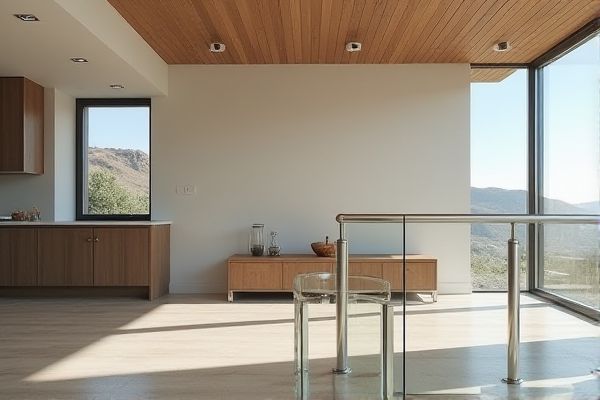
Glass railing offers a modern, sleek aesthetic with unobstructed views and low maintenance compared to traditional wooden railing, which provides a warm, classic look but requires regular upkeep and is susceptible to weather damage. Explore the article to understand which railing type best suits your style and functional needs.
Table of Comparison
| Feature | Glass Railing | Wooden Railing |
|---|---|---|
| Material | Tempered or laminated glass panels | Solid hardwood or softwood |
| Durability | High resistance to weather and corrosion | Susceptible to rot, insects, and weathering |
| Maintenance | Requires regular cleaning to remove smudges | Needs periodic sealing, staining, or painting |
| Visibility | Unobstructed view, enhances space openness | Opaque, blocks view |
| Safety | Tempered glass offers strong impact resistance | Depends on wood quality and construction |
| Installation | Requires skilled labor, precision fitting | Relatively easier and flexible installation |
| Cost | Generally higher upfront cost | Typically lower initial cost |
| Aesthetic | Modern, sleek, minimalist design | Traditional, warm, rustic appeal |
| Environmental impact | Recyclable glass, but energy-intensive production | Renewable resource, but may involve deforestation |
Introduction to Glass and Wooden Railings
Glass railings offer a modern, transparent barrier that enhances visual openness while providing durability and low maintenance, making them ideal for contemporary spaces and outdoor environments exposed to weather. Wooden railings bring a classic, warm aesthetic with natural textures and colors, favored for traditional or rustic settings, though they require regular maintenance to prevent weathering and deterioration. Both materials serve functional safety purposes but differ significantly in appearance, upkeep, and longevity based on environmental exposure.
Aesthetic Appeal: Modern vs Classic Looks
Glass railing offers a sleek, modern aesthetic that enhances your space with transparency and minimalism, making areas feel open and spacious. Wooden railing provides a classic, timeless look characterized by warmth and natural texture, adding character and traditional charm to your environment. Choosing between glass and wooden railings depends on whether you prefer contemporary elegance or enduring, rustic appeal.
Durability and Maintenance Requirements
Glass railings exhibit superior durability due to their resistance to weather elements, corrosion, and insect damage compared to wooden railings, which are prone to rot, warping, and termite infestation over time. Maintenance for glass railings involves regular cleaning with glass-safe products to prevent stains and maintain clarity, while wooden railings require periodic sanding, staining, sealing, or painting to protect against moisture and environmental deterioration. The longevity of glass railings typically surpasses wood, reducing long-term upkeep costs and effort significantly.
Safety Considerations for Homes and Businesses
Glass railings provide enhanced visibility and modern aesthetics while using tempered, laminated glass to ensure high impact resistance, making them a safer choice for homes and businesses concerned about durability and child safety. Wooden railings offer a traditional look but require regular maintenance to prevent splinters, rot, and weakened structural integrity, which can compromise safety over time. Your decision should weigh the clear safety benefits and low maintenance of glass against the natural appeal and upkeep demands of wood.
Cost Comparison: Glass vs Wooden Railings
Glass railings typically have a higher upfront cost due to materials like tempered glass and stainless steel fittings, while wooden railings are generally more affordable initially. Maintenance costs for glass railings are lower since they resist weathering and require minimal upkeep, whereas wooden railings need regular staining or painting to prevent rot and damage. Your choice impacts long-term expenses, with glass offering durability and modern aesthetics at a premium, and wood providing a budget-friendly but higher-maintenance option.
Installation Process and Complexity
Glass railing installation typically requires precise measurements and professional expertise due to the weight and fragility of glass panels, making the process more complex than wooden railing. Wooden railings offer easier installation with basic carpentry tools and skills, allowing for quicker assembly and adjustments on-site. Choosing glass railings may demand more planning and specialized labor, while wooden railings provide a more straightforward approach that can be suitable for DIY projects.
Customization and Design Flexibility
Glass railings offer unparalleled customization with options for tinted, frosted, or clear panels that enhance modern aesthetics and allow for seamless integration with various architectural styles. Wooden railings provide versatile design flexibility through a wide range of stains, carvings, and shapes, making them ideal for traditional or rustic settings. Your choice depends on whether you prioritize sleek, contemporary looks with ease of maintenance or the warm, natural appeal and intricate craftsmanship of wood.
Environmental Impact and Sustainability
Glass railings offer superior environmental benefits due to their recyclability and minimal need for chemical treatments compared to wooden railings, which often require preservatives harmful to ecosystems. Sustainable forestry practices for wood can mitigate impact, but deforestation and slower decomposition rates contribute to a larger carbon footprint. Choose glass railings for a more eco-friendly, long-lasting option that aligns with your commitment to sustainability.
Common Applications and Suitability
Glass railing is commonly used in modern residential and commercial spaces, offering unobstructed views and a sleek aesthetic ideal for balconies, staircases, and pool areas. Wooden railing suits traditional and rustic designs, providing warmth and durability for decks, patios, and garden fences. Your choice depends on whether you prioritize contemporary transparency or classic texture to complement the environment.
Conclusion: Choosing the Right Railing for Your Space
Glass railing offers modern aesthetics, enhanced visibility, and low maintenance, making it ideal for contemporary spaces and outdoor areas where durability is essential. Wooden railing provides a classic, warm appearance with customizable designs, perfect for traditional interiors and locations seeking a natural, rustic charm. Your choice depends on balancing style preferences, maintenance willingness, and the specific functional needs of your space.
 homyna.com
homyna.com